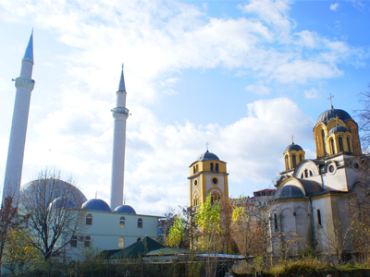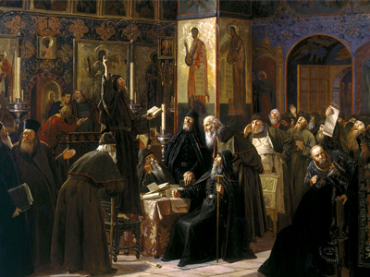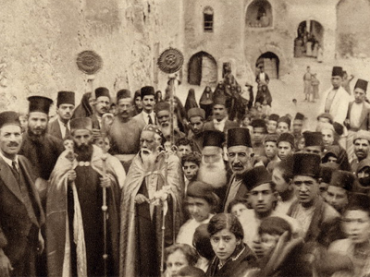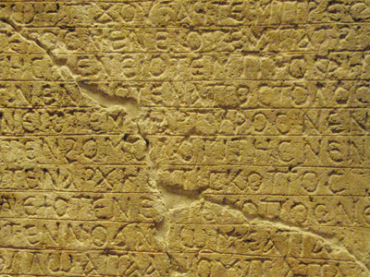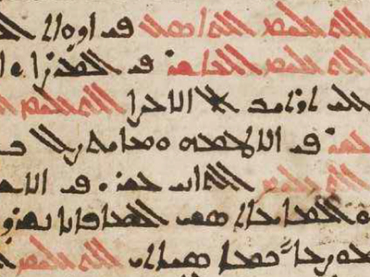Syriac and Eastern Christianity
The Book of the Himyarites
Fragments of a Hitherto Unknown Syriac Work
Edited and Translated by Axel Moberg
Series: Syriac Studies Library 18
ISBN: 978-1-60724-814-9
The Book of the Himyarites, given in Syriac and English translation, deals with the growth of Christianity in Arabia. The introduction provides details about the historical value of the work and its relationship to other related sources.
$175.00
Un évêque-poète au Ve et au VIe siècles
Jacques de Saroug: sa vie, son temps, ses oeuvres, ses croyances
Series: Syriac Studies Library 20
ISBN: 978-1-60724-819-4
In this important work on Jacob of Sarug, Martin examines what is known of the poet’s life, looks at his lasting influence, offers a number of extracts from Jacob’s homilies and letters in French, and discusses his orthodoxy.
$143.00
Inedita Syriaca
Eine Sammlung syrischen Übersetzungen von Schriften griechischer Profanliteratur
Edited with an Introduction by Eduard Sachau
Series: Syriac Studies Library 21
ISBN: 978-1-60724-820-0
Using manuscripts from the British Museum, Sachau here presents a number of unique Syriac texts translated from Greek, including philosophical, medical, and maxim texts. The appendix includes astronomical texts from Sergius of Reshaina and Severus Sebokt.
$154.00
The Treatise of Dionysius bar Salibi Against the Jews
Edited by J de Zwaan
Series: Syriac Studies Library 23
ISBN: 978-1-60724-828-6
This volume contains the Syriac text of one of Dionysius bar Salibi’s polemical writings, that against the Jews, based on a manuscript now located at the Harvard Semitic Museum. An English translation was promised by the editor, but never appeared.
$137.00
Eine jakobitische Einleitung in den Psalter
in Verbindung mit zwei Homilien aus dem grossen Psalmenkommentar des Daniel von Salah
Edited and Translated by Gustav Diettrich
Series: Syriac Studies Library 24
ISBN: 978-1-60724-829-3
This volume contains the Syriac text, with German translation, of an (anonymous) introduction to the Psalms, together with two homilies from Daniel of Salah’s (fl. mid-6th century) long Psalms commentary. Diettrich’s detailed introduction adds richly to the work.
$167.00
Eusebius, Bishop of Caesarea, on the Theophania
A Syriac Version, Edited from an Ancient Manuscript Recently Discovered
Edited by Samuel Lee
Series: Syriac Studies Library 5
ISBN: 978-1-60724-842-2
Samuel Lee arranges texts by the fourth century church historian Eusebius of Caesarea as they are known to him in their surviving Syriac versions.
$169.00
The Book of Kalilah and Dimnah
Translated from Arabic into Syriac
Edited with an Introduction by William Wright
Series: Syriac Studies Library 6
ISBN: 978-1-60724-843-9
This second Syriac version of the famous collection of fables of Indian origin was translated from the Arabic version of ibn al-Muqaffa‘. Wright gives the Syriac text with notes, a lengthy introduction, and select glossary.
$218.00
Kalila und Dimna
Syrisch und Deutsch
Edited and Translated by Friedrich Schulthess
Series: Syriac Studies Library 7
ISBN: 978-1-60724-844-6
From the storied transmission of this famous collection of Indian fables came two Syriac translations. This is an edition of the earlier translation (re-edited after the editio princeps) with German translation and notes.
$218.00
Die armenische Rezension der syrischen Chronik Michales des Großen
By Felix Haase
Series: Analecta Gorgiana 442
ISBN: 978-1-60724-850-7
The Armenian version of the Chronicle of Michael the Great was overshadowed by the discovery of the Syriac version. However, Felix Hasse argues that the unique features of the Armenian text provide an important historical source for the Armenian tradition.
$39.00
Quadragesima und Karwoche Jerusalems im siebten Jahrhundert und Oster- und Pfingster Jerusalems im s
Translated by Theodor Kluge; Introduction by Anton Baumstark
Series: Analecta Gorgiana 443
ISBN: 978-1-60724-851-4
Theodor Kluge publishes a German translation of two Eastern Christian liturgical texts for use in Holy Week, Easter and Pentecost. Anton Baumstark adds notations to the translation and includes an introduction to each text.
$41.00
Ravenna als Vorort aramäischer Kunst
Series: Analecta Gorgiana 444
ISBN: 978-1-60724-852-1
Previous attempts to compare the art and architecture of Ravenna have focused only on Rome and Constantinople, but Josef Strzygowski argues here that the Oriental Christian tradition should be considered as a contributing influence as well.
$37.00
Die Götterliste des Mar Jakob von Sarug in seiner Homilie über den Fall der Götzenbilder
Series: Analecta Gorgiana 445
ISBN: 978-1-60724-853-8
In the early twentieth-century, P.S. Landersdorfer published a translation of Jacob of Serug’s homily on the fall of the idols accompanied by a commentary. Bernhard Vandenhoff publishes here a critique of Landersdorfer’s conclusions about the gods mentioned in Jacob’s “god-list.”
$37.00
Untersuchungen zur Chronik des Pseudo-Dionysios von Tell-Mahrê
By Felix Haase
Series: Analecta Gorgiana 446
ISBN: 978-1-60724-854-5
Felix Haase presents one of the first in-depth surveys of the text of the Chronicle of Pseudo-Dionysius of Tell-Mahre and focuses on the issue of the texts that were used as sources for the composition of the Chronicle
$43.00
Die Kirchenmusik im byzantinischen Reiche und Zur Entzifferung der byzantinischen Notenschrift
By Egon Wellesz
Series: Analecta Gorgiana 447
ISBN: 978-1-60724-855-2
Egon Wellesz presents here an in-depth survey of Christian music in the Byzantine tradition. Wellesz discusses the present state of research and the problems inherent in such a survey, and describes the notation and symbols used in the manuscript tradition.
$44.00
La grande grammaire de Grégoire Barhebraeus
Texte syriaque édité d'après les manuscrits avec une introduction et des notes
Edited with an Introduction by Axel Moberg
Series: Syriac Studies Library 28
ISBN: 978-1-60724-862-0
Moberg had already published a German translation of Barhebraeus’s longer Syriac grammar based on a critically established Syriac text and here presents that text in this volume, along with an introduction (in French) and two indices (Syriac and French).
$178.00
Opuscula Nestoriana
Four East Syriac Treatises
Edited with an Introduction by Georg Hoffmann
Series: Syriac Studies Library 30
ISBN: 978-1-60724-866-8
This volume contains four East Syriac treatises: two dealing with words forms and lexicography, two dealing with the interpretation of difficult words in the Bible. The book will be of interest to students of Syriac grammar and biblical interpretation.
$134.00
Homilies of Isaac of Antioch
Edited with an Introduction by Paul Bedjan
Series: Syriac Studies Library 32
ISBN: 978-1-60724-870-5
Under the name of Isaac of Antioch, also known as the Great, or the Teacher, more than 200 memre exist. Here Bedjan produces the (vocalized) Syriac text of 67 memre, 43 edited for the first time.
$299.00
Das Buch von der Erkenntniss der Wahrheit oder der Ursache aller Ursachen
Edited with an Introduction by C. Kayser
Series: Syriac Studies Library 34
ISBN: 978-1-60724-876-7
This volume contains a unique theological-philosophical text in Syriac known as the Book on the Knowledge of the Truth, or the Cause of Causes. The author describes it as “a common book for all peoples under heaven.”
$156.00
Syrische Grammatik des Mar Elias von Tirhan
Edited and Translated by Friedrich Baethgen
Series: Syriac Studies Library 35
ISBN: 978-1-60724-877-4
Baethgen produces here both the Syriac text and a German translation with notes, including remarks on Elias’s grammar in connection with Greek and Arabic grammatical traditions; the Syriac text includes textual notes.
$120.00
John of Mosul's Book of Beautiful Guidance
Edited with an Introduction by Elias Ioannes Millos
Series: Syriac Studies Library 36
ISBN: 978-1-60724-878-1
John of Mosul’s (died 1270) poem of spiritual guidance in the seven-syllable meter deals with, among other things, learning and the reading of Scripture, fasting, prayer, the Lord’s Prayer, parents instructing their children in doctrine, astrology and magic, etc.
$156.00
Une version syriaque des Aphorismes d'Hippocrate
Texte et traduction
Edited and Translated by Henri Pognon
Series: Syriac Studies Library 37
ISBN: 978-1-60724-879-8
Pognon gives here the Syriac text of Hippocrates’ Aphorisms, together with a French translation. Each part contains detailed textual and translational notes and is prefaced with a thorough introduction. The book concludes with a Syriac-Greek glossary of medical terms.
$130.00
Denkmäler altarmenischer Meßliturgie
Translation and Introduction by Peter Ferhat & Anton Baumstark
Series: Analecta Gorgiana 448
ISBN: 978-1-60724-882-8
Joseph Catergian’s Die Liturgien bei den Armeniern was significant for liturgical studies in the Armenian tradition, but it lacked translations of the texts. The present publication includes translations by Peter Ferhart, Anton Baumstark, and Adolf Rücker.
$47.00
Ein frühchristliches Theotokion in mehrsprachiger Überlieferung und verwandte Texte des ambrosianisc
Series: Analecta Gorgiana 449
ISBN: 978-1-60724-883-5
Anton Baumstark compares the Greek text of a Theotokion preserved in a sixth-century manuscript to comparable texts from the Oriental Christian traditions and the Western Ambrosian Rite.
$36.00
Studien zur äthiopischen Kirchenmusik
By Egon Wellesz
Series: Analecta Gorgiana 450
ISBN: 978-1-60724-884-2
Egon Wellesz presents here a thorough study of music in the Ethiopic Christian tradition. Wellesz’s discussion includes a survey of previous literature, a comparison of musical features with other traditions, and examples of Ethiopic musical texts.
$38.00
Paradigmengebete ostsyrischer Kirchendichtung
Translation and Introduction by Anton Baumstark
Series: Analecta Gorgiana 451
ISBN: 978-1-60724-885-9
Anton Baumstark surveys the possible literary sources for liturtgical hymn prayers of the Eastern Syriac tradition and also provides a Latin translation of nineteen such prayers found in Bedjan’s Chaldean Breviary.
$38.00
Filter by
Filter by price
Filter by manufacturer

